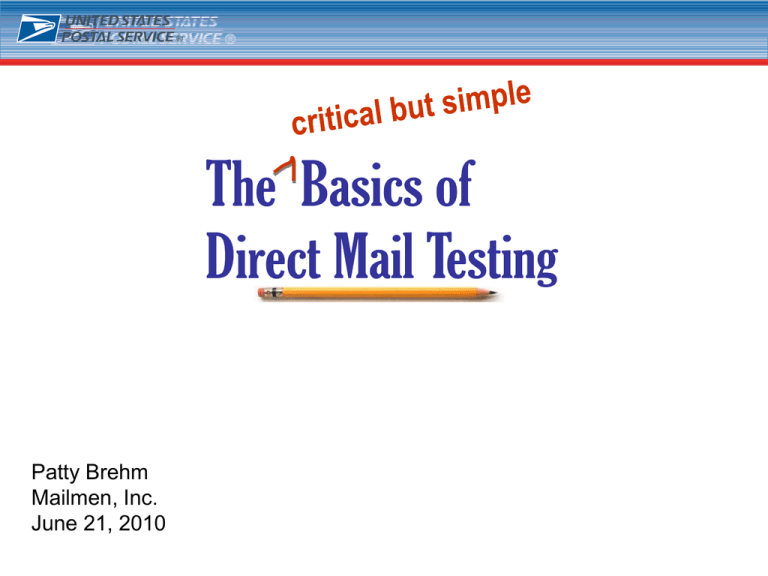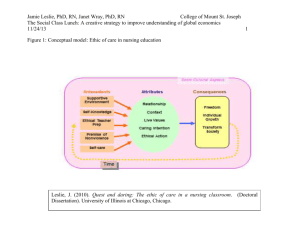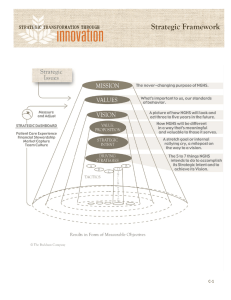The Basics of Direct Mail Testing critical but simple
advertisement

Patty Brehm Mailmen, Inc. June 21, 2010 1 The plain pencil is symbolic of both the attitude and the practice of the true testing direct marketer: 1. You get up close to the numbers. 2. You must be prepared to make a lot of changes. 2 “If you're not failing every now and again, it's a sign you're not doing anything very innovative.” 3 "It is common sense to take a method and try it. If it fails, admit it frankly and try another. But above all, try something.“ Franklin Delano Roosevelt 32nd U.S. president …and if you want to stand out from the crowd you have no choice but to keep experimenting. 4 What do the best direct mailers know and how do they know it? ► They know how customer behavior differs at various seasons of the year. They keep complete records of what is mailed when. ► They know which sets of customers are their most profitable, and which sets are a drag on their bottom line. They assign each customer an RFM* score. (* to be explained) ► They know who tends to respond to what type of offers. They integrate codes into each offer and each list. ► They know when to spend more money on a mailer and when to save money and get the same results. 5 A real-life example of the direct mail and email test records kept by a major retailer: 6 Product: Watches Season: Graduation Time 15% Off, Free Engraving Prestige Name Brands 7 Aim Properly When You Test: Your goal is to gain knowledge that will translate to true insight into your business. Response rates and income are secondary and will grow as your knowledge grows. 8 What do you test first… The package or the list? ► Create a basic direct mail piece and begin with the basics. ► Keep it as simple as possible, without a lot of “bells and whistles” in the package. ► Use examples of fairly well proven techniques and avoid expensive and ultra-creative formats. ► Then begin testing lists using this same piece. 9 How many different elements can you test at a time? 10 ► Don’t skimp on data kept ► If in doubt, record it ► # of pieces mailed, list used ► Weather, mailing circumstances, major news events ► Number of responses, source of responses ► Average order size ► Conversion rate ► Response rate ► Cost per thousand for the piece ► Cost per order ► Percentage of no-pays, returns, etc ► ROMI ► Any differences in ordering trends ► Methods of payment ► Response methods chosen What do you record for each test? 11 Q: What should you do with test numbers after a test is complete? A: After analysis, write a “verbatim” of your test. You should have an official report for every mailing. That report should contain: ► A description of the test ► The purpose of the test ► The components of the mailer ► Statistical data ► Complete results ► A numerical and a verbal analysis ► Action steps advised as a result of the test Source: Dean Reick, CEO, Creative Direct LLC 12 “Initial tests have a nasty tendency to be flaky. So you should always retest, especially when you get a positive result or a significant change in results. It's tempting to instantly toss anything that fails and adopt anything that wins. But it often pays to be patient. Test it again and see if you get similar results before making a decision.” Dean Reick, CEO, Creative Direct LLC 13 Your test results should be the most important determinant of your list, offer, formats and creative strategies ongoing. “Learn to observe and trust the data, not your ‘gut instincts’. Your gut doesn’t know squat.” Steve Cuno, Chairman, The Response Agency, Inc. Author: Prove It Before You Promote It: How to Take the Guesswork Out of Marketing. 14 ► Recency: When was the last customer interaction? ► Frequency: How frequent has this customer been in his or her interactions with the business? ► Monetary: What is the sum total of his her or her purchases over the past cycle? (usually 1 year) 15 ► Score your customers. ► Rank or “decile” them. ► Overlay demographics. ► Overlay attitudes & lifestyles 16 Record # Scoring Recency Frequency Monetary RFM A35976 1 3 3 7 C45022 5 3 1 9 R48232 3 1 5 9 A98301 3 5 5 13 B48937 0 1 3 4 J94837 1 5 3 9 Purchase in past 90 days…….5 Purchase in past 6 months…..3 Purchase in past 12 months…1 Purchased over 1 year ago…..0 Purchase 4 or more x annual……..5 Purchase 2 or more x annual……..3 Purchase annually………………….1 Purchased less than annually …..0 Spend over $2000 annually…..5 Spend over $1000 annually ….3 Spend over $500 annually……1 Less than…………………….…..0 17 Deciling A decile is any of the nine values that divide the sorted data into ten equal parts, so that each part represents 1/10 of the sample or population. Thus: ► The first decile consists of the top tier of customers.* ► The 5th decile is the top half, the 3rd decile is top quartile. ► The 8th decile represents the least responsive, least valuable, and least profitable customers. Market Deciles can be ranked highest to lowest or vice versa * Some statisticians do it the opposite way, with the 1st decile lowest 18 Overlays By overlaying geographic, demographic and psychographic (attitude & lifestyle) data, you can build a PROFILE VIEW of your various deciles and take your testing to an even higher level. A basic model built by a database consultant will cost from between $2500 - $7500 for basic profile/models. For huge databases, etc., the cost goes up from there. 19 Customer Profiling is a relatively static process that builds a “profile view” of your deciles. Customer Modeling is an active process that builds a model of the prime target for a particular product, offer, or initiative. Both methods have their place for the ongoing testing and databased mailer. 20 Once you begin keeping and tracking data, you can go deeper and deeper in your applications. Here is an example of a RETURNS ANALYSIS – THOSE WHO RETURN SALES TO A RETAILER. This is a national retailer whose average transaction is under $90. They had over 400,000 customers shopping in Spring, 2009, of which 354,000 had only sales, i.e., no returns. 21 22 Source: Claude Johnson Associates Perhaps an emphasis on making customers happy and comfortable about ► They retained 34.5% of customers from Spring to Fall ’09. merchandise, as stayed well at ► The best ofreturning the best spent over $1000 and as making it easier to do so…. a rate of 81.5%. ► 47% of purchase-returners came back, 12% higher than the mean percentage retained customers. MIGHTofBE A GOOD IDEA? ► And the average spend for the returners is $200 compared to $127 for those who did not return items! ► If the non-returners had come back and spent like those returners, the company would have realized another $7.7 million in revenue!!! 23 Thought for the day: Every business is a big bathtub that has cracks and leaks. 24 Your acquisition programs are the faucets that fill the tub with water (new customers). Some water leaks out because customers move to new phases in their lives. Some just don’t need your services very often. Some feel like they were mistreated. Some like other tubs better. Some water leaks out because customers can’t afford to stay in the tub anymore. 25 26 Basics of Building a Predictive Modeling System Segmentation is a way of grouping people or organizations with similar demographic profiles, attitudes, purchasing patterns, buying behaviors or other attributes to help understand customers more thoroughly and thus market to them more effectively. The problem is many businesses use segmentation to only recognize that every customer has some unique characteristics, providing a somewhat superficial view for each….then all you have is “one-to-some,” which is not much better than “one-to-all.” Source: David Vergera, Director of Product Marketing, SPSS Analytics, Chicago IL 27 ► Create customer segments to enable differential marketing programs. ► Use past purchase data and demographics to construct customer subgroups. ► Isolate key performance factors linked to long-term customer value as major data drivers for the segmentation. ► Link product line or category affinity to each subgroup. ►Example: Develop marketing plans incorporating value-based You may have to offer less expensive budgeting and category affinity to make programs value-added specials to certain sub-groups to keep them more relevant and efficient. from deserting you altogether. Source: David Vergera, Director of Product Marketing, SPSS Analytics, Chicago IL 28 Summary and Take-Aways ► Aim Properly: Your goal is knowledge and you search for specific bits of knowledge with each test. ► Start with a basic direct mail piece, and test it against lists. ► Then test offers. Lists and offers are 80% of the power of mail. ► Score by RFM, then build segmentation clusters. ► Make marketing decisions that are relevant to each group. 29 The LI PCC would like to thank today’s session sponsor Thank you Bi-County Mailing 30 31











